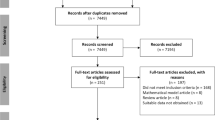Abstract
Estimators for the population sizes of animal species are similar to Horvitz-Thompson estimators — they involve dividing counts of detected animals by the probabilities of detection. Knowing detection probabilities for different subpopulations allows one to estimate each sub-population size with such an estimator, and to add the results for an estimator of the total population. In the case where the proportions of animals belonging to the different sub-populations are also known, this paper shows that using those proportions to arrive at a common average detection probability will, when used in conjunction with the total number of animals detected, result in a better estimator. We provide two examples where the inferior estimator may seem sensible.
Similar content being viewed by others
References
Burnham, K.P., Anderson, D.R. and Laake, J.L. (1980) Estimation of density from line transect sampling of biological populations. Wildlife Monograph No. 72. Wildlife Society, Blacksburg, Virginia.
Hayne, D.W. (1949) An examination of the strip census method for estimating animal populations. Journal of Wildlife Management, 13, 145–57.
Lesser, V.M. and Bodenroeder, P. (1994) Procedures and analysis of data collected for the 1993 Oregon Parks and Recreation survey. Technical Report, Survey Research Center, Department of Statistics, Oregon State University, Corvallis, Oregon 97331.
Ramsey, F.L., Wildman, V.J. and Engbring, J. (1987) Covariate adjustments of effective area in variable area wildlife surveys. Biometrics, 43, 1–11.
Ramsey, F.L., Gates, C.E., Patil, G.P. and Taillie, C. (1988) On transect sampling to assess wildlife populations and marine resources. In P.R. Krishnaiah and C.R. Rao (eds) Handbook of Statistics, Vol. 6. North-Holland, Amsterdam.
Reynolds, R.T., Scott, J.M. and Nussbaum, R.A. (1980) A variable circular plot method for estimating bird numbers. Condor 82, 309–13.
Särndal, C.E., Swensson, B. and Wretman, J. (1992) Model Assisted Survey Sampling. Springer-Verlag, New York.
Scott, J.M., Ramsey, F.L. and Kepler, C.B. (1986) Forest Bird Communities of the Hawaiian Islands: Their Dynamics, Ecology and Conservation. Studies in Avian Biology, No. 9.
Seber, G.A.F. (1982) The Estimation of Animal Abundance, 2nd edn. Griffin, London.
Thompson, S.K. (1992) Sampling. John Wiley, New York.
Thompson, S.K. and Seber, G.A.F. (1994) Detectability in conventional and adaptive sampling. Biometrics, 50, 712–24.
Author information
Authors and Affiliations
Rights and permissions
About this article
Cite this article
Ramsey, F.L., Lesser, V.M. Conditional and unconditional estimators of population size. Environ Ecol Stat 2, 181–190 (1995). https://doi.org/10.1007/BF00456663
Received:
Revised:
Issue Date:
DOI: https://doi.org/10.1007/BF00456663




